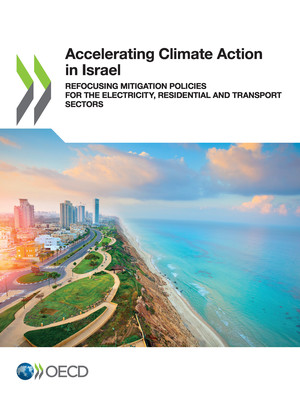Executive Summary
The development of Israel’s long-term low emissions development strategy (LT-LEDS), a process led by the Ministry of Environmental Protection in Israel and supported by the OECD’s Environment Directorate, provides a unique opportunity to align efforts across the government to create a low-emissions future. So far, 17 countries have submitted LT-LEDS to the UNFCCC. Even though, Israel’s greenhouse gas (GHG) emissions are small in global terms; emissions have been rising in recent years. If Israel continues on this trajectory, emissions would rise about 23.6% by 2030 (from 80.18 MtCO2e in 2015 to nearly 99.1 MtCO2e by 2030).1 Putting in place policy packages in the near-term is essential to achieve the deep emission reductions needed in the longer-term.
This report is one input to whole of government discussions for the development of a roadmap to support Israel’s LT-LEDS. It offers policy recommendations based on in-depth analysis for next five to ten years in the electricity, residential and transport sectors that will not only reduce emissions now, but will also kick-start the systemic transformations needed beyond that. The report takes a well-being approach, recognising that climate change is just one of Israel’s policy priorities and climate action must be fully integrated into other societal agendas – income, jobs, affordable housing, reliable energy, improved accessibility, good air quality, health, life quality in cities, and biodiversity. While written before the COVID-19 crisis, this report can also inform decisions on Israel’s recovery from this crisis, helping to ensure that recovery measures integrate climate action and avoid lock-in to “inferior” carbon-intensive paradigms that may also entrench inequalities and reduce life quality more broadly.
Prioritising renewable energy over fossil fuel generation in the electricity sector ensures a pathway to low-carbon future, whilst safeguarding well-being. The use of the recently discovered natural gas resources in Israel can reduce GHG emissions (compared to coal), but creating an electricity system based predominantly on natural gas will jeopardise deep decarbonisation goals due to the lock-in of carbon intensive infrastructure and will not fully resolve air pollution problems. Solar PV, in contrast, is cheaper than gas and its use would reduce air pollution and improve health, create jobs as well as provide other benefits. Pricing fossil fuels according to their carbon content - and other external damages from extraction and use - will discourage the use of natural gas. In the meantime, Israel can scale up renewable electricity deployment by removing administrative barriers, upgrading the transmission network, and promoting energy efficiency to reduce future strain on the grid (e.g., strengthening energy performance standards). In parallel, pursuing demand-side responsiveness (i.e. managing when consumers use electricity) can facilitate flexibility in the grid and better accommodate the expansion of renewables.
The residential sector is undergoing a rapid transformation in Israel, since the government is in the process of building 1.5 million new homes by 2040. Ensuring that these new homes use state-of-the-art designs to minimise energy usage to the greatest extent possible during the building’s life is pertinent to avoid locking-in carbon-intensive housing, for example, by establishing emission limits on buildings (since none presently exist for new or existing buildings). Likewise, minimising embodied carbon (from construction, retrofits, and demolition of buildings), for example, by using green public procurement will help to reduce emissions across the lifecycle of a building. Managing and planning for rapid growth in housing in cities, e.g. via minimum densities, urban infill, or redeveloping brownfield sites, is also key to create cities that are more compact and sustainable. Nevertheless, careful attention needs to be paid to ensuring the continued liveability of cities as they become denser, for example, by upgrading infrastructure, planning for green spaces to curb heat island effects and contribute to physical and mental health, and guaranteeing that newly built homes are accessible to opportunities and services. Devolving responsibility to municipalities and increasing their financial capacity will help to better guide this growth in light of local circumstances.
In transport, focusing policies on accessibility (the ease of reaching opportunities) rather than mobility (physical movement) can unlock greater emission reductions. Mainstreaming accessibility criteria into appraisal methodologies of projects is a means to steer investment towards public transport (buses, trams, and so on) and active modes (e.g., walking or cycling). Reallocating and re-designing road space in Israel as to prioritise public and active transport modes will help ease the transition away from private vehicles. In addition, tools such as congestion charging and parking policies will enable a more efficient use of space. Better aligning fuel taxation with the carbon content of fuels, for example, by phasing out tax benefits for diesel consumption, will also help to limit environmental and social damage. Accessibility-focused policy could be facilitated by shifting funding and responsibility towards local levels, for example, via Metropolitan Transport Authorities in order to enhance responsiveness whilst avoiding over-fragmentation of responsibilities.
Note
← 1. Ministry of Environmental Protection (2018): Israel’s third national communication on climate change
This document, as well as any data and map included herein, are without prejudice to the status of or sovereignty over any territory, to the delimitation of international frontiers and boundaries and to the name of any territory, city or area. Extracts from publications may be subject to additional disclaimers, which are set out in the complete version of the publication, available at the link provided.
https://doi.org/10.1787/fb32aabd-en
© OECD 2020
The use of this work, whether digital or print, is governed by the Terms and Conditions to be found at http://www.oecd.org/termsandconditions.


